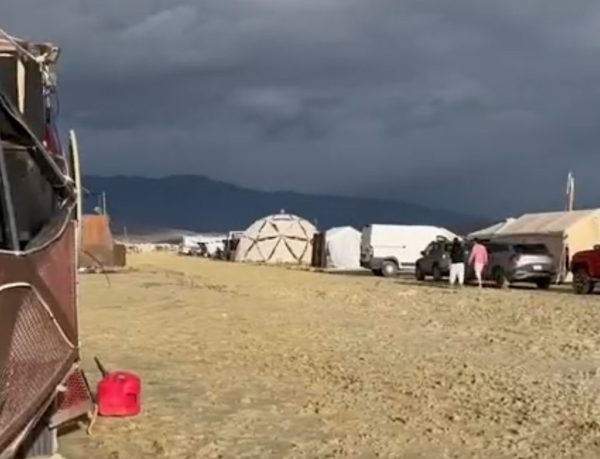Burning Man, the world-renowned annual festival held in the Black Rock Desert of Nevada, faced unexpected challenges this year, as heavy rainfall transformed the iconic event into a muddy disaster, leaving over 70,000 attendees stranded and struggling to conserve vital resources.
From Aug. 27 to Sept. 4, attendees typically gather to celebrate art, music and community, culminating in the burning of the iconic “Man” structure on the second to last day.
However, this year, a record-breaking 0.8 inches of rain drenched the desert, equivalent to two to three months’ worth of precipitation for northwest Nevada.
Due to the downpour, attendees struggled to maneuver in the muck, with mud-coated shoes, feet and car tires. Organizers and local authorities issued a shelter-in-place order, urging attendees to conserve food, water and fuel. Roads in and out of the event were closed to prevent vehicles from getting stuck and worsening the muddy predicament.
While some determined individuals embarked on extreme treks to reach the exit, most RVs remained immobilized in the muddy terrain. Attendees claimed the conditions made walking or biking impossible.
“I think the people planning the event could have checked for heavy rainfall,” said junior Gia Lasher, a biology major.
Lasher also said that better preparation and appropriate gear for rain could have made the situation more manageable.
The Pershing County Sheriff’s Office and festival organizers noted that they were not sure how long it would take for the roads to clear enough for vehicle travel. The temporary city of Black Rock, which is built annually to host the festival, had to close its gates and airport to all but emergency vehicles.
Stranded attendees, expecting a weekend of art and community, found themselves rationing supplies, including water, food, fuel and charging devices. Panic ensued as many tried to cancel flights, book hotels and share news online, leading to limited service and thousands of dead phones.
The situation left countless visitors dehydrated and hungry, emphasizing the need for better preparedness in the face of such unforeseen events.
Faith Varner, a junior equestrian studies student at the Savannah College of Art and Design, has attended Burning Man in the past.
“I would still want to go back to Burning Man, even after the unfortunate event that occurred, as long as there were emergency plans in place for future events,” Varner said. “Most people attending have researched the festival, where they understand the dangers that could occur in the event of a flash flood.”
In an attempt to make the best of a difficult situation, some attendees embraced the mud, creating sculptures to bring a sense of fun and creativity to the challenging conditions.
A few days after the initial rainfall, organizers set up mobile cell trailers throughout the event to provide Wi-Fi access, and buses were arranged to help those wishing to leave the festival grounds.

Dr. Kristine White, an environmental science instructor at GC, stated that she believes the rains are indirectly linked to climate change.
“Due to climate change and extra heat energy being stored in the ocean, it did not cool as much as it has in the past, which then brings extra heat and moisture that will shift the regional weather patterns,” White said.
The unpredicted rainfall in Black Rock Desert sparked media coverage concerning the effects of climate change and the negative outcomes that are not far behind.
Burning Man’s official website had cautioned attendees to be prepared for unexpected weather.
“Long, sustained rainfall is uncommon, but storm cells may bring high winds, lightning, and rain, so you should be mentally and physically prepared for this,” Burning Man officials said.
Located on the event’s website, their “Survival Guide” recommended bringing plenty of essential supplies, such as a bucket — in case the portable restrooms were out of commission — clothing suitable for colder temperatures, ample food, medicine and a battery or solar-powered radio.
This incident highlights the importance of thoroughly reading and adhering to a festival’s survival guide, which could have helped attendees cope better with the challenges they faced.
As the festival ended, attendees and organizers alike reflected on the unexpected turn of events and the need for improved disaster preparedness, ensuring that future Burning Man festivals can continue to be celebrated in the spirit of art, music and self-expression.


